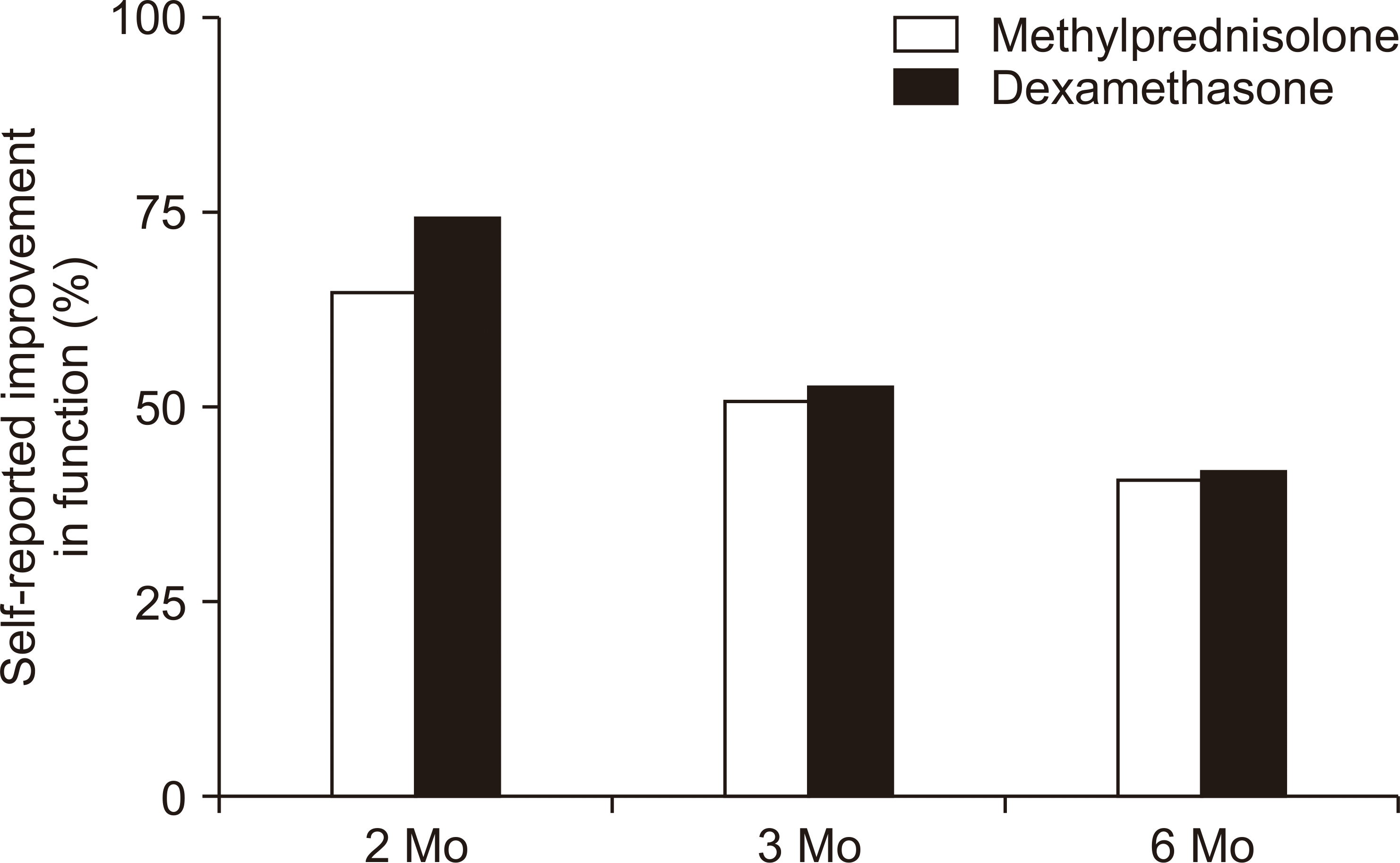1. Buenaventura RM, Datta S, Abdi S, Smith HS. 2009; Systematic review of therapeutic lumbar transforaminal epidural steroid injections. Pain Physician. 12:233–51. PMID:
19165306.
2. Ghahreman A, Ferch R, Bogduk N. 2010; The efficacy of transforaminal injection of steroids for the treatment of lumbar radicular pain. Pain Med. 11:1149–68. DOI:
10.1111/j.1526-4637.2010.00908.x. PMID:
20704666.

3. Kaufmann TJ, Geske JR, Murthy NS, Thielen KR, Morris JM, Wald JT, et al. 2013; Clinical effectiveness of single lumbar transforaminal epidural steroid injections. Pain Med. 14:1126–33. DOI:
10.1111/pme.12122. PMID:
23895182.

4. MacVicar J, King W, Landers MH, Bogduk N. 2013; The effectiveness of lumbar transforaminal injection of steroids: a comprehensive review with systematic analysis of the published data. Pain Med. 14:14–28. DOI:
10.1111/j.1526-4637.2012.01508.x. PMID:
23110347.

5. Roberts ST, Willick SE, Rho ME, Rittenberg JD. 2009; Efficacy of lumbosacral transforaminal epidural steroid injections: a systematic review. PM R. 1:657–68. DOI:
10.1016/j.pmrj.2009.04.008. PMID:
19627959.

6. Vad VB, Bhat AL, Lutz GE, Cammisa F. 2002; Transforaminal epidural steroid injections in lumbosacral radiculopathy: a prospective randomized study. Spine (Phila Pa 1976). 27:11–6. DOI:
10.1097/00007632-200201010-00005. PMID:
11805628.
7. Dietrich TJ, Sutter R, Froehlich JM, Pfirrmann CW. 2015; Particulate versus non-particulate steroids for lumbar transforaminal or interlaminar epidural steroid injections: an update. Skeletal Radiol. 44:149–55. DOI:
10.1007/s00256-014-2048-6. PMID:
25394547.

8. Hodler J, Boos N, Schubert M. 2013; Must we discontinue selective cervical nerve root blocks? Report of two cases and review of the literature. Eur Spine J. 22(Suppl 3):S466–70. DOI:
10.1007/s00586-012-2642-z. PMID:
23328873. PMCID:
PMC3641255.
11. Kennedy DJ, Dreyfuss P, Aprill CN, Bogduk N. 2009; Paraplegia following image-guided transforaminal lumbar spine epidural steroid injection: two case reports. Pain Med. 10:1389–94. DOI:
10.1111/j.1526-4637.2009.00728.x. PMID:
19863744.

12. Ludwig MA, Burns SP. 2005; Spinal cord infarction following cervical transforaminal epidural injection: a case report. Spine (Phila Pa 1976). 30:E266–8. DOI:
10.1097/01.brs.0000162401.47054.00. PMID:
15897816.
13. Popescu A, Lai D, Lu A, Gardner K. 2013; Stroke following epidural injections--case report and review of literature. J Neuroimaging. 23:118–21. DOI:
10.1111/j.1552-6569.2011.00615.x. PMID:
21699610.

14. Somayaji HS, Saifuddin A, Casey AT, Briggs TW. 2005; Spinal cord infarction following therapeutic computed tomography-guided left L2 nerve root injection. Spine (Phila Pa 1976). 30:E106–8. DOI:
10.1097/01.brs.0000153400.67526.07. PMID:
15706327.

15. Wybier M, Gaudart S, Petrover D, Houdart E, Laredo JD. 2010; Paraplegia complicating selective steroid injections of the lumbar spine. Report of five cases and review of the literature. Eur Radiol. 20:181–9. DOI:
10.1007/s00330-009-1539-7. PMID:
19680658.

17. MacMahon PJ, Shelly MJ, Scholz D, Eustace SJ, Kavanagh EC. 2011; Injectable corticosteroid preparations: an embolic risk assessment by static and dynamic microscopic analysis. AJNR Am J Neuroradiol. 32:1830–5. DOI:
10.3174/ajnr.A2656. PMID:
21940803.

19. Shah RV. 2014; Paraplegia following thoracic and lumbar transforaminal epidural steroid injections: how relevant are particulate steroids? Pain Pract. 14:297–300. DOI:
10.1111/papr.12110. PMID:
24152137.

20. Dreyfuss P, Baker R, Bogduk N. 2006; Comparative effectiveness of cervical transforaminal injections with particulate and nonparticulate corticosteroid preparations for cervical radicular pain. Pain Med. 7:237–42. DOI:
10.1111/j.1526-4637.2006.00162.x. PMID:
16712623.

21. Lee JW, Park KW, Chung SK, Yeom JS, Kim KJ, Kim HJ, et al. 2009; Cervical transforaminal epidural steroid injection for the management of cervical radiculopathy: a comparative study of particulate versus non-particulate steroids. Skeletal Radiol. 38:1077–82. DOI:
10.1007/s00256-009-0735-5. PMID:
19543892.

22. Park CH, Lee SH, Kim BI. 2010; Comparison of the effectiveness of lumbar transforaminal epidural injection with particulate and nonparticulate corticosteroids in lumbar radiating pain. Pain Med. 11:1654–8. DOI:
10.1111/j.1526-4637.2010.00941.x. PMID:
20807343.

23. Berkwits L, Davidoff SJ, Buttaci CJ, Furman MB. Lee TS, editor. 2012. Lumbar transforaminal epidural steroid injection, supraneural (traditional) approach. Atlas of image-guided spinal procedures. Elsevier Saunders;Philadelphia: p. 93–103.
24. Denis I, Claveau G, Filiatrault M, Fugère F, Fortin L. 2015; Randomized double-blind controlled trial comparing the effectiveness of lumbar transforaminal epidural injections of particulate and nonparticulate corticosteroids for lumbosacral radicular pain. Pain Med. 16:1697–708. DOI:
10.1111/pme.12846. PMID:
26095339.

25. Kennedy DJ, Plastaras C, Casey E, Visco CJ, Rittenberg JD, Conrad B, et al. 2014; Comparative effectiveness of lumbar transforaminal epidural steroid injections with particulate versus nonparticulate corticosteroids for lumbar radicular pain due to intervertebral disc herniation: a prospective, randomized, double-blind trial. Pain Med. 15:548–55. DOI:
10.1111/pme.12325. PMID:
24393129.

26. El-Yahchouchi C, Geske JR, Carter RE, Diehn FE, Wald JT, Murthy NS, et al. 2013; The noninferiority of the nonparticulate steroid dexamethasone vs the particulate steroids betamethasone and triamcinolone in lumbar transforaminal epidural steroid injections. Pain Med. 14:1650–7. DOI:
10.1111/pme.12214. PMID:
23899304.






 PDF
PDF Citation
Citation Print
Print




 XML Download
XML Download